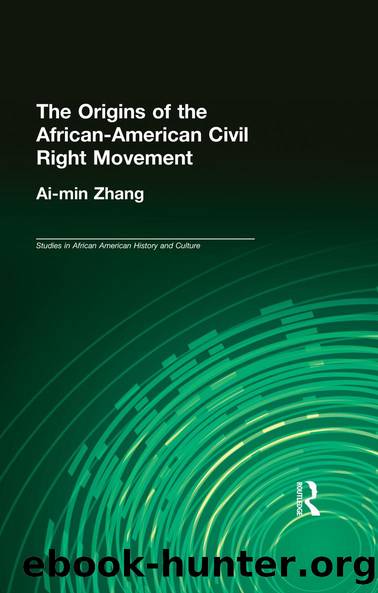The Origins of the African-American Civil Rights Movement by Ai-min Zhang

Author:Ai-min Zhang [Zhang, Ai-min]
Language: eng
Format: epub
ISBN: 9781317794653
Barnesnoble:
Publisher: Taylor & Francis
Published: 2014-05-22T00:00:00+00:00
The Involvement of the Left in the Fight for Racial Justice
Compared with other American institutions and organization in late 1930s, the Left had expressed itself best in the struggles for equality of African Americans. It most successfully exposed the evils of racism, inspired American people's intuitive knowledge and educated the members of the left organizations. It had been struggling for innocent Angelo Herndon, a young black to be treated justly and given back his freedom. It succeeded in the end and this elevated the spirits of African Americans and educated them politically. It helped and subsidized some new civil rights organizations in order that their radical ideas and viewpoints could have chances to affect those older organizations. Thus their tactics of struggles became more militant and easier for American mainstream culture to embrace. Many magazines belonging to the Left denounced racism and encourage some African American writers to give up their ideas of black nationalism and separatism and support racial harmony. The Left also encouraged labor organizations to absorb African Americans and it mobilized whites to oppose discrimination. It took advantaged its own economic and political power to influence state legislatures and Congress to pass several acts that were beneficial to blacks.
The American Communist Party had very limited influence among blacks before 1931. It had set up such organizations as The American Negro Labor Congress and The League of Struggle for Negro Rights, but everyday blacks and black newspapers did not pay much attention to it. The total number of members of the party was 7,500 in the early 1930s, among which 150 to 200 were blacks. Very few black party members were concerned with the issue of socialism.19 But the situation changed considerably after March 1931.
On March 25, 1931, a train filled with young unemployed whites and blacks was running southward. A conflict developed between some of the black youths and some whites. The blacks overpowered the whites and ejected them from the train. The angry whites reported the incident to the police. The train was stopped near Paint-Rock in Alabama. The local policemen arrested nine blacks and brought two white women who were found among them to the police station. The white women accused the blacks of having raped them. They said that the nine blacks had used knives to force them to conform. The accusations spread like wildfire and a crowd of whites gathered in front of the Paint-Rock court. Their plan was to lynch the blacks. The black youths were then moved to the prison in Scottsboro, Alabama. The governor of state sent 25 fully armed national guardsmen to maintain order. In a racially charged atmosphere, in spite of numerous contradictions and inconsistencies in the women's testimony, the youths were found guilty of rape. Eight of them were sentenced to be put to death by electrocution, and the ninth, the youngest, was given a sentence of life in prison. This was the famous Scottsboro case.20
On the day that the decision was announced, the national committee of American Communist Party issued a long denunciation of the court's decision.
Download
This site does not store any files on its server. We only index and link to content provided by other sites. Please contact the content providers to delete copyright contents if any and email us, we'll remove relevant links or contents immediately.
| Africa | Americas |
| Arctic & Antarctica | Asia |
| Australia & Oceania | Europe |
| Middle East | Russia |
| United States | World |
| Ancient Civilizations | Military |
| Historical Study & Educational Resources |
Goodbye Paradise(2974)
Men at Arms by Terry Pratchett(2408)
Tobruk by Peter Fitzsimons(2065)
Pirate Alley by Terry McKnight(1911)
Arabs by Eugene Rogan(1841)
Borders by unknow(1791)
Belonging by Unknown(1473)
The Biafra Story by Frederick Forsyth(1327)
It's Our Turn to Eat by Michela Wrong(1305)
Botswana--Culture Smart! by Michael Main(1239)
A Winter in Arabia by Freya Stark(1226)
Gandhi by Ramachandra Guha(1198)
Coffee: From Bean to Barista by Robert W. Thurston(1184)
Livingstone by Tim Jeal(1154)
The Falls by Unknown(1143)
The Source by James A. Michener(1137)
The Shield and The Sword by Ernle Bradford(1102)
Egyptian Mythology A Fascinating Guide to Understanding the Gods, Goddesses, Monsters, and Mortals (Greek Mythology - Norse Mythology - Egyptian Mythology) by Matt Clayton(1089)
Africa: Altered States, Ordinary Miracles by Richard Dowden(1080)
